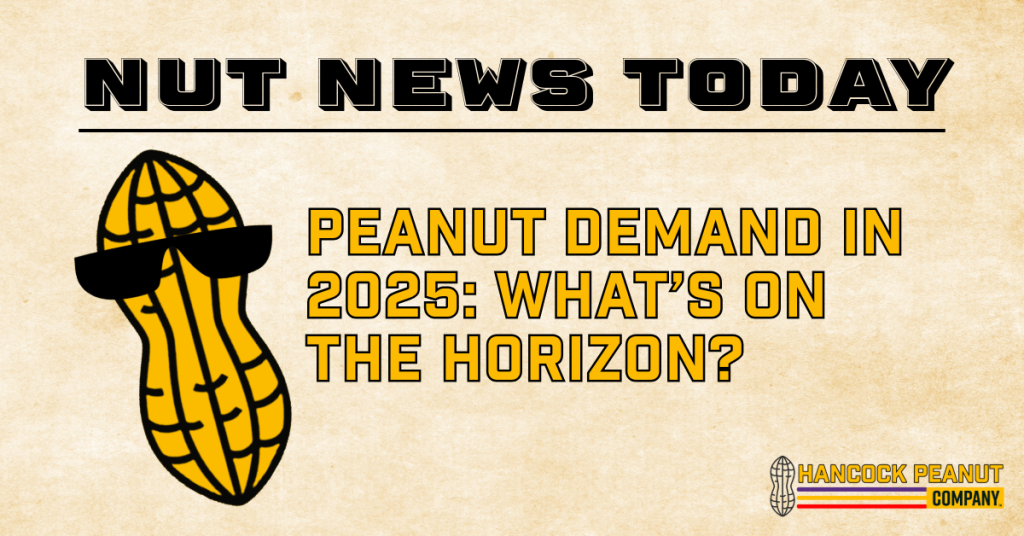Peanut Demand in 2025: What’s on the Horizon?
Why Hancock Peanut Company Should Be Your Go-To Source for Premium Peanuts
As we move into 2025, the demand for peanuts is set to continue its upward trajectory, driven by evolving consumer preferences, health-conscious trends, and innovative food products. Peanut consumption is experiencing a major surge globally, and whether you’re a retailer, manufacturer, or consumer, it’s important to stay ahead of this growing trend. Shop’m here.

Key Trends Driving Peanut Demand in 2025
- Health and Wellness Focus Peanuts have long been valued for their nutritional benefits, and with the rise of health-conscious eating, this trend shows no signs of slowing down. Peanuts are an excellent source of protein, healthy fats, and essential vitamins, which makes them a staple for plant-based diets and athletes alike. As more consumers seek natural, nutrient-dense foods, peanuts are becoming a go-to snack and ingredient in many health-focused products. Expect this to continue in 2025, with peanuts being featured in everything from smoothies and protein bars to vegan cheese alternatives.
- Peanut-Based Products On the Rise From peanut butter to peanut flour, oil, and even peanut milk, there is an increasing diversity of peanut-based products on the market. In 2025, innovations in food technology will make peanuts even more versatile, expanding their role in gluten-free, keto, and plant-based products. Major food brands are already experimenting with peanut butter alternatives, while small startups are developing new uses for peanuts in snack foods and protein-rich meals.
- Sustainability and Traceability Sustainability continues to be a key concern for consumers, and peanuts are gaining attention for their relatively low environmental impact compared to other protein sources like beef. Peanuts use less water and land, and they enrich the soil they grow in by fixing nitrogen. This makes peanuts an environmentally friendly crop, which is a huge selling point as consumers and manufacturers increasingly prioritize sustainable sourcing. In 2025, this trend is expected to continue, with more transparency about where peanuts are sourced and how they’re grown.
- Global Demand While peanuts have long been a staple in the U.S., global demand is rising rapidly, particularly in emerging markets. The growth of middle-class populations in countries like China and India has sparked increased interest in peanut-based products, and this trend is expected to continue in 2025. As these markets expand, peanut farmers and suppliers will be focused on meeting the needs of both domestic and international consumers.
Why Choose Hancock Peanut Company?
With this surge in demand and innovation, it’s essential to source your peanuts from a reliable, high-quality supplier. Hancock Peanut Company stands out as a top choice for premium peanuts. With years of expertise in the peanut industry, Hancock is committed to providing fresh, high-quality peanuts that meet the needs of today’s consumers. Whether you’re a snack company looking to add a fantastic product or a retailer stocking shelves with the best snacks on the market, Hancock Peanut Company offers a range of products to meet your needs.
Why Hancock Peanut Company?
- Quality and Freshness: Hancock sources only the best peanuts, ensuring that every batch is fresh and ready to meet the highest quality standards.
- Sustainability: Hancock is dedicated to environmentally responsible farming practices, making it a great choice for companies and consumers focused on sustainability.
- Versatility: From roasted peanuts to peanut butter and peanut oil, Hancock offers a diverse selection of peanut products to cater to your unique business needs.
- Global Reach: With an established reputation and the infrastructure to supply large quantities, Hancock is equipped to meet the growing global demand for peanuts.
Looking Ahead
As we look to the future, the peanut industry is poised for exciting growth. With rising demand driven by health trends, sustainability efforts, and product innovation, peanuts are in a prime position to become even more embedded in our everyday diets. For anyone looking to capitalize on this growing market, Hancock Peanut Company is the trusted partner to ensure your business is ahead of the curve.
Don’t wait for the future to arrive—buy your peanuts from Hancock Peanut Company today and be ready for what’s next!
Follow us on social here: Instagram | Facebook | Twitter | Threads | LinkedIn | TikTok
Peanut Demand in 2025: What’s on the Horizon? Read More »











